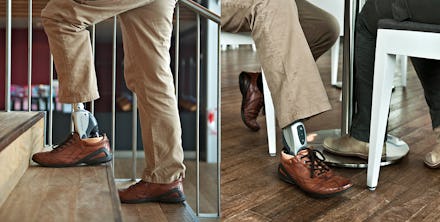Mind-Controlled Bionic Legs Are Here. Welcome to the Future.

These are the first amputees to be able to subconsciously control their prosthetic lower limbs. How? With implants developed by Össur, an orthopedics company in Reykjavík, Iceland.
According to Reuters, Össur created tiny implanted myoelectric sensors to surgically install in patients' remaining leg-muscle tissue. These sensors then connect to a receiver in a prosthetic limb. Once attached, test patients said, it took only minutes to get the hang of their new bionic legs.
Össur said its technology is the first to use sensory implants to send signals between the muscles and the prosthesis. Previous devices used transplanted muscle tissue, which required the brain to relearn how to control the limb. This works much more quickly.
"As soon as I put my foot on, it took me about 10 minutes to get control of it," said patient Gummi Olafsson, who lost part of his leg in a childhood accident. "I could stand up and just walk away. Come back, sit down, use my muscles to move my foot in the position I wanted to use it ... You couldn't believe the feeling."
Olafsson told Reuters using the limb was "strange and overwhelming": "I was moving it with my muscles. There was nobody else doing it; the foot was not doing it, I was doing it."
How it works: Thorvaldur Ingvarsson, an orthopedic surgeon and Össur's director of research and development, says the brain gives impulses directly to the sensor-injected muscles, which then contract in response. The sensors then act as a middle man, sending the brain's signals to the prosthetic legs, making them do whatever the wearer wants.
"Our ultimate goal is to replace the function of the lost limb, and we've been doing so step-by-step and doing very well. However, as our technology [moves] on — you have sensors for muscles, you're able to replace function by the new mind-controlled prosthetics — the next step might be to get sensing from the environment so you have a feedback loop," Ingvarsson told Reuters.
Össur's sensor-equipped bionic limbs include an extremely advanced knee, making it possible for amputees to move over uneven terrain, walk down steps and even stand upright on an incline while bearing a load — something that, without a good, functional knee, is difficult to do.
While the technology won't be publicly available for three to five years, this is a major leap forward for prosthetic limbs, and will hopefully spark other prosthetic companies to develop similar products. It may not be long before we see this sort of advanced prosthetic for extremely accessible prices.
h/t Reuters